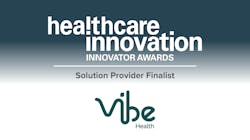Innovator Awards Vendor Finalist: Vibe Health by eVideon

The healthcare industry has shifted in response to the consumerism wave to which people have grown so accustomed. What does this look like in terms of innovation and a patient-centric approach?
Since the onset of the pandemic, it’s become apparent that healthcare consumers are no longer asking for the convenience of mobile applications and virtual care options—they expect it. In the same way that people can choose their seat on an airplane, or pay their credit card bill from their phone, they want that approach when interacting with their healthcare providers.
While some might say that healthcare is not as transactional as other industries, or point to staff shortages and budget constraints as factors inhibiting the speed of innovation in healthcare, technology is now a vital part of the patient and staff experience. And it is the way forward.
Our hospital customers would agree that technology adaptation in the acute settings allows for greater touch, greater face time, and greater intimacy with the patient and clinician. It cuts down on duplicative, mundane tasks and allows care teams to practice at the top of their license.
In many hospitals and health systems today, there seems to be a gap between providers and patients. How does technology soften this gap and put the “care” back into healthcare?
We need to humanize healthcare, and I believe one way we can do that is by empowering patients to be active participants in their healthcare journey. Inviting patients behind the curtain and providing resources for education and self-care removes unnecessary burden from providers and allows patients to stake a claim in their overall health trajectory.
It's also important to point out that asynchronous communication is extremely empowering. Oftentimes patients don’t want to bother the nurse to ask for a glass of water or a blanket because they know these professionals are inundated with a constant stream of requests. Technology in the hospital room—whether it’s a bedside tablet used for specific needs or a digital communication board outlining a patient’s progress and Rx dosages—provides a bridge for those receiving and giving care to have the optimal experience available to them.
October is Healthcare Literacy Month. How does technology play a role in improving healthcare literacy?
I have been in the industry for over 30 years and the issue of healthcare literacy is one that has come up time and time again. Technology offers a way to wire into an organization a thoughtful engagement strategy that is color blind, age blind, and religion blind. Everyone comes to technology with the same opportunity to improve their education and physical outcomes. For patients to maximize the benefits of technology, hospital systems must make it as inclusive as possible. And, it's up to us as healthcare leaders to pave a way for everyone who wants to engage with tech platforms to be able to use them.
Research has shown that approximately 80 million adults in the United States are estimated to have limited or low health literacy. There is much to be done about that, and a step in the right direction is allowing patients in every room access to digital solutions that enable them to participate in real-time conversations about their care.
What makes Vibe Health different from the competition?
Our biggest differentiator is our robust suite of offerings—we are truly building the “hospital room of the future” with our clients. While the in-room television continues to be a great way to personalize the care environment for patients, our clients are now using our technology as mission-critical clinical information tools. The digital whiteboard and digital door sign are incredibly data dense tools that deliver the right information at the right time for both the care team and the patient. We take a pride in being an exceptional partner for the hospital systems we work with, and customer-driven innovation is what drives us. We have a front-row seat to victories and pain points on the clinical side, and we never walk away from finding new ways to solve problems and celebrate together.
Are there other advantages of smart technology that you and your clients are seeing now?
We have an effective way of integrating our platform with our clients’ existing technology stack, including the electronic medical record (EMR). Our hospital clients tell us repeatedly that our technology has helped them to extract more value from the EMR, which can exceed a million-dollar investment for most hospitals. That’s always music to our ears.

